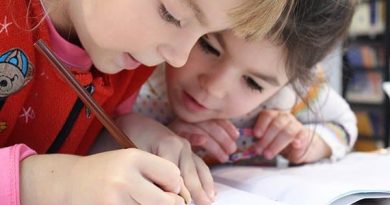Can We Apply Design Thinking in Education?
Many schools claim that their systems support innovation and creativity in the educational process, yet the results indicate a failure to implement the proper methodologies in order to achieve this aim. One of the main reasons for this is the educational approach itself. The “learn-memorize-test” approach implemented by many schools prevent student from exploring the creativity inherent in the children and fail to improve it through every day processes.
One of the methodologies that has been proven to have successful results is the “design thinking” approach. The design thinking is a human-centered method that focuses on people rather than products or technologies to solve problems. The design thinking approach implements a number of tools that are built on observation, brainstorming and reach innovative solutions through the knowledge acquired through the design thinking process.
While many organizations and companies conduct research toward further implementation of the design thinking in a schools’ curricula, there is a debate around the suitability of applying design thinking methods and tools on children whom are in a young age range. Can this educational method be applied universally to students in different schools and age range, or it is more suitable to specific school years and curricula?

Design Thinking Models for Schools
Applying the design thinking approach in schools requires implementing the proper design process. Currently, there are two models that target schools children; the Frog’s Collective Action Toolkit and the IDEO’s Design Thinking for Educators, Both models implicate number of steps that seek a better understanding to the problem and reach innovative solution. The Frog’s Collective Action Toolkit process includes the following:
- Clarify goal: in this step, the problem should be identified and the goal that is required to be achieved by each working group be recognized. The goal can change based on the knowledge acquired by the team during the design thinking process.
- Build: this step includes building the group who will work to solve the problem and achieve the specified goal. In this step, the group learns more about the problem and shared goals.
- Seek: this step targets having a better understanding to the problem by reaching out to community members and ask the right questions to learn more about the unmet needs. This can be achieved through investigating the issues related to the problem, holding interviews, getting feedback from members, and creating pattern quests.
- Imagine: the group in this step imagine new solutions for the problem and discuss how to turn these imaginary ideas into action. This can be achieved through number of methods such as the jam session, idea remix, grow an idea and cull the set.
- Make: since we cannot know if the idea will work until trying it, this step focuses on testing the idea and building experience based on these tests. This can help in discovering more issues that were not known in the first place.
- Plan: after acquiring the knowledge and the vision about solving the problem and achieving goal, this step helps the group to build a concrete plan of action that helps to understand the goal as well as what and how are the best ways to achieve it.

The IDEO has a different model that focuses on educating teachers and faculty about the design thinking process. This model come in five main steps as follows:
- Discovery: in order to create a feasible solution for the problem, this step aims to build a solid understanding of the idea that is shared by the design thinking group. The step targets opening new opportunities and learning more about the design challenge.
- Interpretation: this step targets to turn the collected information into an organized and meaningful insights rather than fragments of information. This step involves methods such as storytelling and sorting thoughts.
- Ideation: this step involves generating and exploring different ideas without constraints in order to boost creativity to the max through a large number of ideas.
- Experimentation: this step converts the ideas to prototypes in order to build a better understanding to the ideas and which one is applicable through analyzing each prototype. It helps to improve ideas and refine them for better results.
- Evolution: this step is very similar to the plan step in the Frog model as it builds an action plan based on the experiences acquired during the design thinking process.

While both models have similar steps, the Frog model tends to evaluate the goals frequently during the process, which make the goal more flexible and changeable for better results and solutions for the problem.
Benefits of Applying Design Thinking
Applying the above steps in school curricula helps in fueling children’s creativity and improve their thinking/innovation skills in multiple disciplines. Generally, the above models helps young learners to acquire the following skills:
- The ability to isolate problems and identify characteristics in order to build an understanding to the goals that need to be achieved.
- Brainstorm possible solutions for the problems based on collecting data and discussing creative solutions with group of students and peers.
- Evaluate and examine solutions based on prototypes and models that help in learning more about proposed solutions.
- Appreciate failure and learn from experience in future projects.
One of the examples of implementing design thinking is the Nueva School in Calif. The school integrates design thinking in everyday classes with the support of the Innovation Lab.
“It’s really a way to make people more effective and to supercharge their innate capabilities,” said Kim Saxe
At Nueva, the students are asked to solve problems via design. One of the projects was to design a LED lamp for one of the family members. Instead of jumping directly to the design process, the students had to select one of the family members and collect information about how that family member used the lamps –in order to provide unique design that meet with him or her interest.
Implementation Barriers
In her website, Debbie Morrison, raised an interesting observation about applying design thinking in school children. Most of the design thinking models are initially designed for architects and designers who already have previous experience with the tools and the skills required to apply these models. On the other hand, the school’s children do not have this required information, which may cause the design thinking process to be inefficient compared with the ordinary learning methods. Therefore, the children’s age and education level should be considered before applying the design thinking model.
Meanwhile, Debbie recognizes both Frog and IDEO design thinking models as successful to achieve targets through toolkits that educate teachers how to apply the design thinking in classes. These models have two different approaches; the first one encourages educators to use design thinking to address class problems, and the other teaches students how to apply design thinking to solve problems.
While many schools claim a creative educational process, few are able to achieve creativity in education. Design thinking can help schools to focus on creativity and innovation in everyday class activities. While design thinking models help students to acquire more skills, it must be cautioned that young learners may not have all the required skills to apply design thinking steps. Educators need to consider this fact while providing design thinking models for their students based on the age range and education level.







There are many things in life which the human beings learns on the fly , even without teachers, and they do it on their own.My youngest sister learned the art of creating artwork on hands with mehndi and that also without the help of any teacher.When she was two and half years old she operated the computer to watch her favorite cartoon movies . But when she went to school , her school record is average and sometimes she even failed.She is average in school but when it comes to creativity she is very good.Now the question is “Is she an average student ? Or Is she Intelligent according to her creative skills.
Hi Santokh,
I totally agree. I am a university professor and alwasy say that human potentials can’t be only graded with numbers. However, teaching the design thinking in schools can help students to change their mindset to look at different situation based on the deisgn process or the critical thining flow. This helps them to feul self learning skills not only in school but also in life. Thanks! Rafiq
Naturally, not all students(particularly younger students) have the experience, vocabulary or skills to implement a more detailed Design Thinking model. I would argue that developing ‘experience’, ‘vocabulary’ & ‘skills’ are the reason children are at school in the first place! The beauty of utilising a Design Thinking model is that it can be used in a simple or more detailed version depending on the age & ability of students. We use a 3 step model of Engage, Ideate & Prototype at our Pre Prep to Year12 school. I have used it in its simplest form with our Pre prep students who are 3-4 years old & through the use of more complicated strategies within each stage, we use it with our eldest students in year 12. Design Thinking is a human Centred problem solving approach. At its core are the dispositions or mindsets that are developed in our students that are skills that teach them how to solve problems. Skills that are also important in educating students to become life long learners & not passengers in their ever changing future.